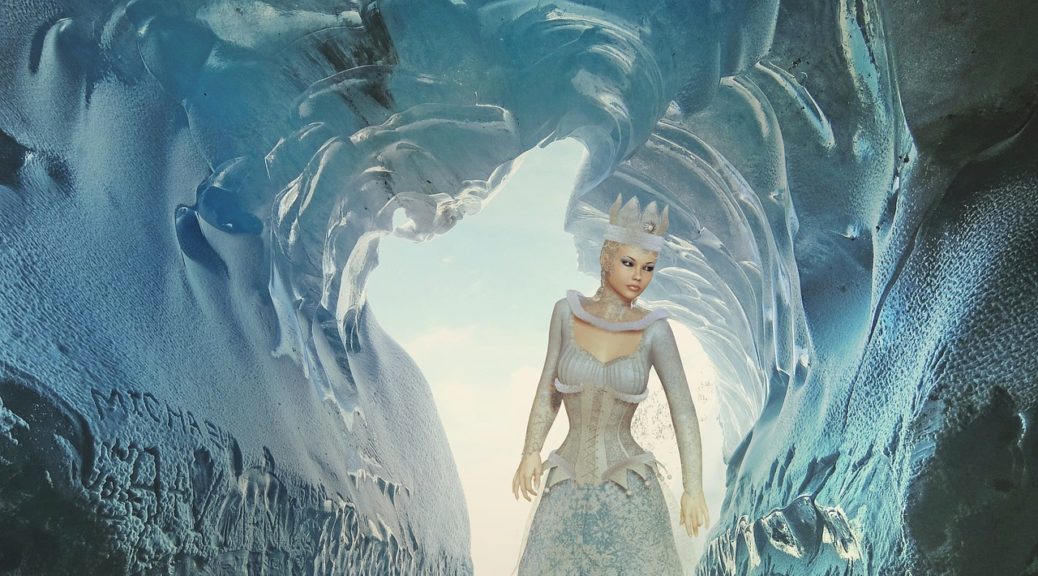The Norse Gods: Skadi
 Skadi is a Norse goddess who embodies the power of winter, hunting, and skiing. She is one of the most fascinating and complex goddesses in Norse mythology. Skadi’s name means “shadow” or “shade,” which reflects her mysterious and enigmatic nature.
Skadi is a Norse goddess who embodies the power of winter, hunting, and skiing. She is one of the most fascinating and complex goddesses in Norse mythology. Skadi’s name means “shadow” or “shade,” which reflects her mysterious and enigmatic nature.
Skadi is the daughter of the giant Thiazi and the wife of the god Njord. She is often depicted as a fierce and independent woman who roams the mountains and forests of the north, hunting with her bow and arrow. Because of this, her fierce spirit is often depicted through her association with wolves, which are considered her sacred animal.
Skadi’s Demand for Justice
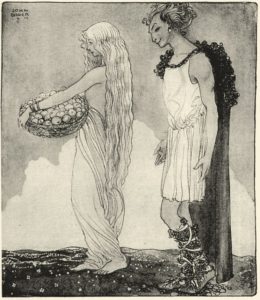 Skadi’s story is one of revenge, power, and redemption. According to Norse mythology, Loki killed Skadi’s father, Thiazi. Thiazi kidnapped Loki, forcing the trickster god to lure Idunn and her golden apples away from Asgard so Thiazi could kidnap her. The golden apples gave the gods immortality, so they made Loki rescue Idunn and her apples. In his escape, Loki kills Thiazi.
Skadi’s story is one of revenge, power, and redemption. According to Norse mythology, Loki killed Skadi’s father, Thiazi. Thiazi kidnapped Loki, forcing the trickster god to lure Idunn and her golden apples away from Asgard so Thiazi could kidnap her. The golden apples gave the gods immortality, so they made Loki rescue Idunn and her apples. In his escape, Loki kills Thiazi.
In retaliation, Skadi set out to seek justice for her father’s death. She went to Asgard, the home of the gods, and demanded retribution. The gods agreed to make amends by allowing Skadi to choose a husband from among them, but with a catch: she had to choose him by looking only at his feet.
Skadi agreed to the gods’ condition. She chose the god with the most beautiful feet, thinking it was Baldr. But it was not Baldr’s but Njord’s feet. Njord is a sea god, and his realm is vastly different than Skadi’s. Despite her initial disappointment, Skadi agreed to marry Njord, but their marriage was not without its challenges.
Skadi and Njord’s Separation
 Skadi and Njord’s differing lifestyles and interests caused tension in their relationship. In retrospect, this difference is quite apparent. Skadi loved the mountains and the snow, while Njord preferred the cold and waves of the sea. They eventually separated, but not before Skadi had learned to appreciate the beauty of the sea and Njord had learned to appreciate the ruggedness of the mountains.
Skadi and Njord’s differing lifestyles and interests caused tension in their relationship. In retrospect, this difference is quite apparent. Skadi loved the mountains and the snow, while Njord preferred the cold and waves of the sea. They eventually separated, but not before Skadi had learned to appreciate the beauty of the sea and Njord had learned to appreciate the ruggedness of the mountains.
Skadi’s Importance to the Norse

Skadi’s association with winter and skiing has made her an important figure in Viking and Scandinavian culture. Skiing was an essential part of life for the ancient Norse people, who used skis for transportation, hunting, and warfare. Skadi is often depicted as a skilled skier, and she is considered the patron goddess of skiing and winter sports.
Skadi’s story has also been interpreted as a metaphor for the power of nature and the importance of balance in life. Her marriage to Njord represents the balance between the sea and the mountains, and her journey to Asgard represents the power of nature to seek justice and balance in the world.
Skadi in the Modern Era
In modern times, Skadi has become a symbol of feminine strength and independence. She represents the power of women to stand up for themselves and seek justice, even in the face of adversity. Her association with winter and skiing has also made her an icon of the outdoors and the natural world.
In conclusion, Skadi is a fascinating and complex goddess whose story has been told and retold for centuries. She embodies the power of winter, hunting, and skiing, and her story is a reminder of the importance of balance, justice, and the power of nature. Skadi’s spirit lives on in the modern world, inspiring women and men alike to seek adventure, explore the outdoors, and embrace the wild and unpredictable aspects of life.
Did you know you can become my patron for as little as $5 a month? This entitles you to content not posted anywhere else. Plus you get to see posts like this three days before the public! Without patrons, I’d be having a very hard time keeping this blog going. Become a patron today!Become a Patron!
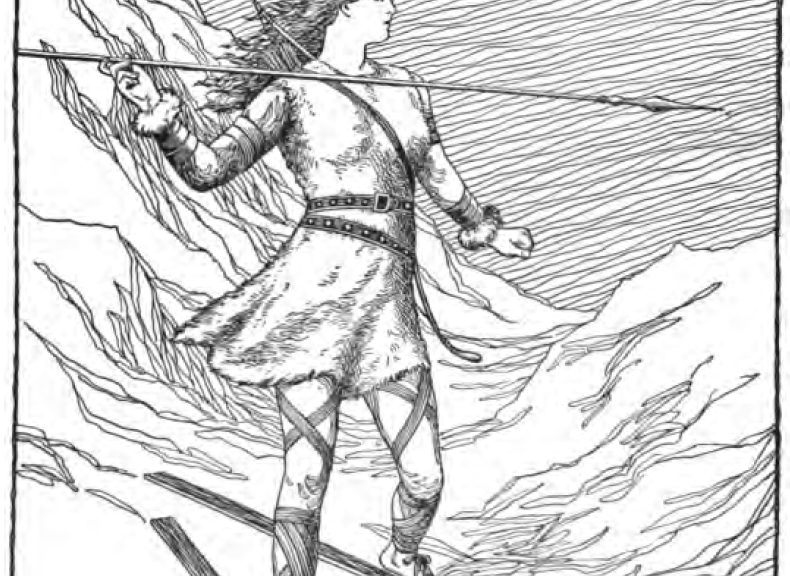

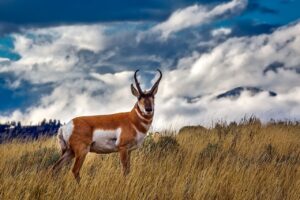
 So, many of you know that
So, many of you know that 
 So, our next hunts were a bit of a disaster. We got on antelope three more times and for various reasons, they spooked, the shot was off, or some other problem. It got bad. Really bad.
So, our next hunts were a bit of a disaster. We got on antelope three more times and for various reasons, they spooked, the shot was off, or some other problem. It got bad. Really bad. The next day was the beginning of deer season. My spouse woke me up and told me a buck was on our property. I went out there, and after losing the buck for a bit, found him behind me. I shot and he landed in a place where we could get to him. My spouse, incidently, was late to work helping me dress out the buck.
The next day was the beginning of deer season. My spouse woke me up and told me a buck was on our property. I went out there, and after losing the buck for a bit, found him behind me. I shot and he landed in a place where we could get to him. My spouse, incidently, was late to work helping me dress out the buck.
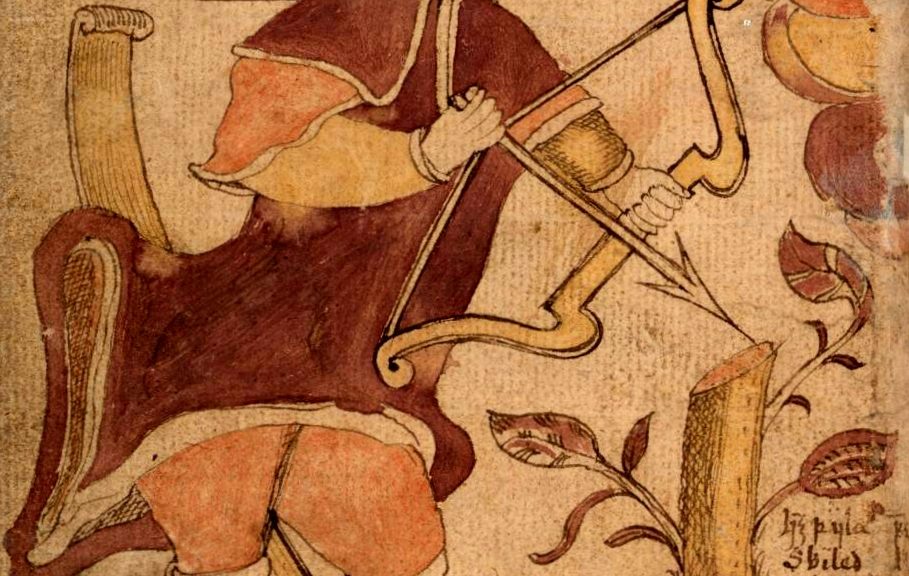
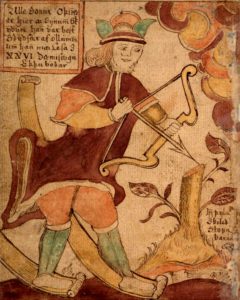 Now we come to Ullr, and by the gods, there isn’t a lot written up about him. Which is a shame, because Ullr was an important god in the Northern countries. Ullr is the god of wintertime sports and hunting. He is also the god of oaths; our ancestors swore on Ullr’s oath ring. Ullr was called on in duels, presumably to oversee the contest or to grant favor. He was also the head of Asgard when Odin was in exile for ten years.
Now we come to Ullr, and by the gods, there isn’t a lot written up about him. Which is a shame, because Ullr was an important god in the Northern countries. Ullr is the god of wintertime sports and hunting. He is also the god of oaths; our ancestors swore on Ullr’s oath ring. Ullr was called on in duels, presumably to oversee the contest or to grant favor. He was also the head of Asgard when Odin was in exile for ten years.
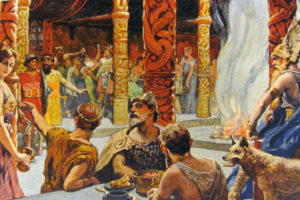 I ran into
I ran into  Yes, I know
Yes, I know 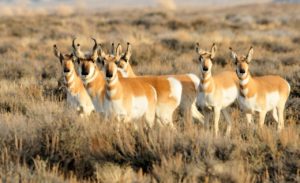 the next county–or next country, for that matter. Having gotten within 300 yards (that’s three football fields) of a pronghorn antelope I was trying to shoot and having the entire herd bust us and run away at 60 miles per hour (second fastest land animal), let me say, it has been more than frustrating.
the next county–or next country, for that matter. Having gotten within 300 yards (that’s three football fields) of a pronghorn antelope I was trying to shoot and having the entire herd bust us and run away at 60 miles per hour (second fastest land animal), let me say, it has been more than frustrating. So, I’m running late to get to an appointment. I’m cold, I’m tired, and I’m sore from chasing animals in the back country. I literally get in the car and am about to turn the key when I look up. About fifty yards away from the truck is a buck. A legal buck. In a safe place with good angles, if I shot him. The only bad side of the entire thing is that, well, I’m in my truck. Without my rifle, orange, or tags. And I’m late, late, late to an appointment. Oh, and if he leaves, he’s going down a 50 plus foot embankment, and assuming I hit him, I’m going to have a Hel of a time trying to get him out of there by myself until my husband comes home.
So, I’m running late to get to an appointment. I’m cold, I’m tired, and I’m sore from chasing animals in the back country. I literally get in the car and am about to turn the key when I look up. About fifty yards away from the truck is a buck. A legal buck. In a safe place with good angles, if I shot him. The only bad side of the entire thing is that, well, I’m in my truck. Without my rifle, orange, or tags. And I’m late, late, late to an appointment. Oh, and if he leaves, he’s going down a 50 plus foot embankment, and assuming I hit him, I’m going to have a Hel of a time trying to get him out of there by myself until my husband comes home.
